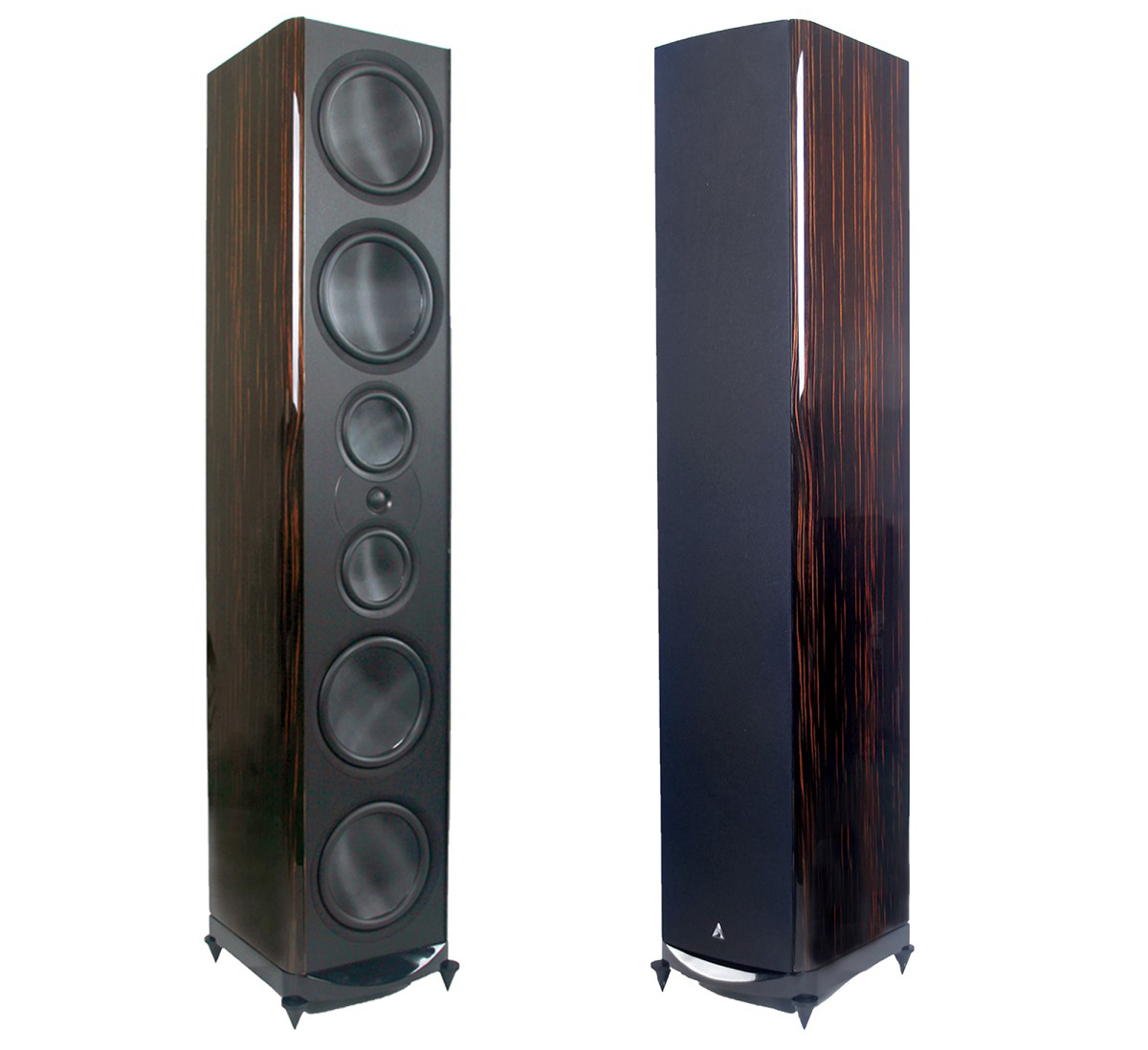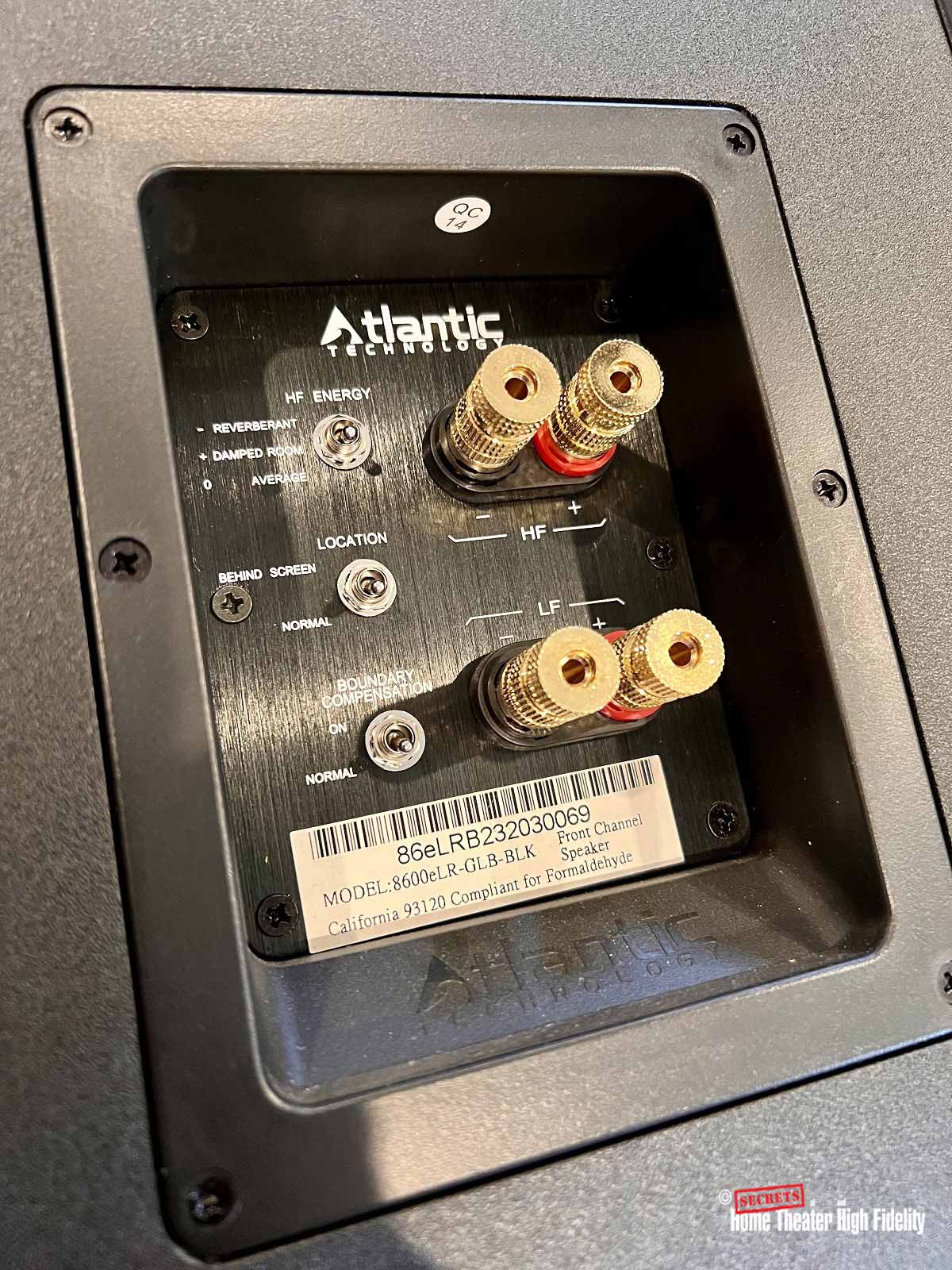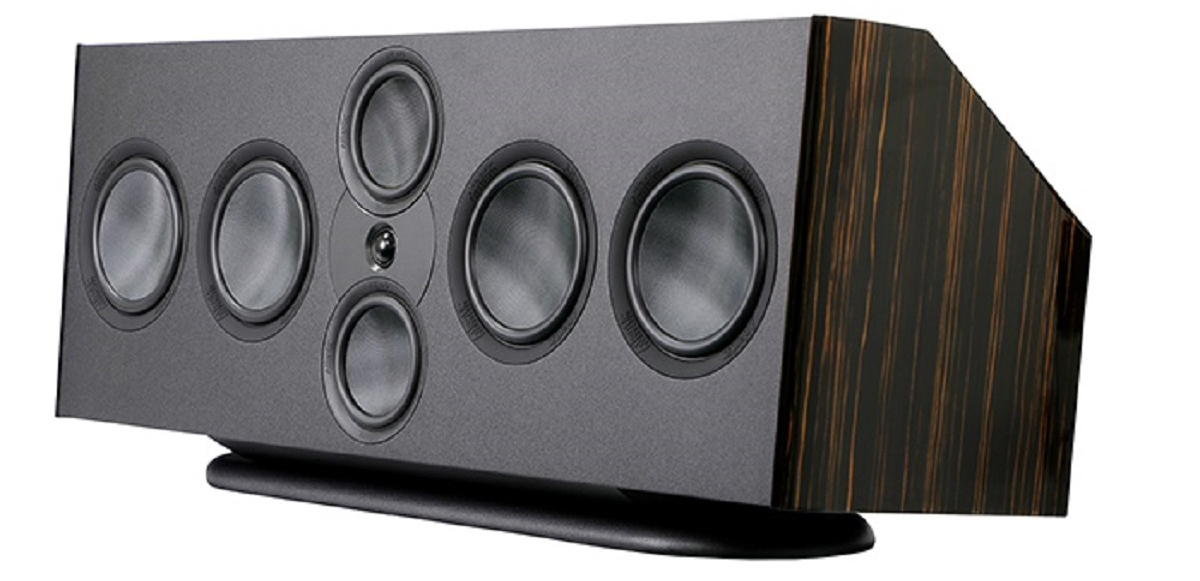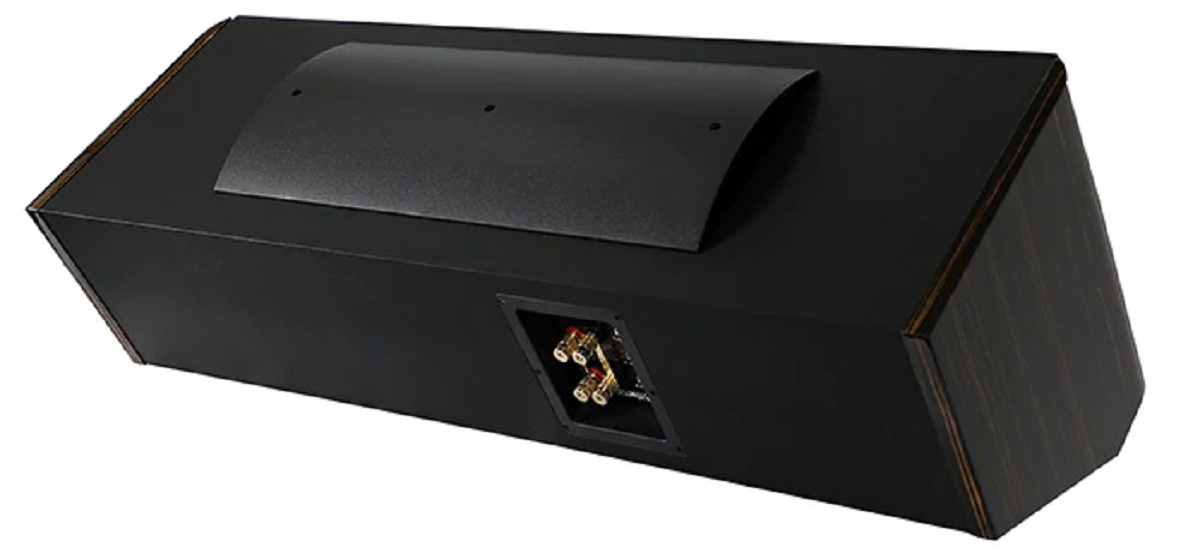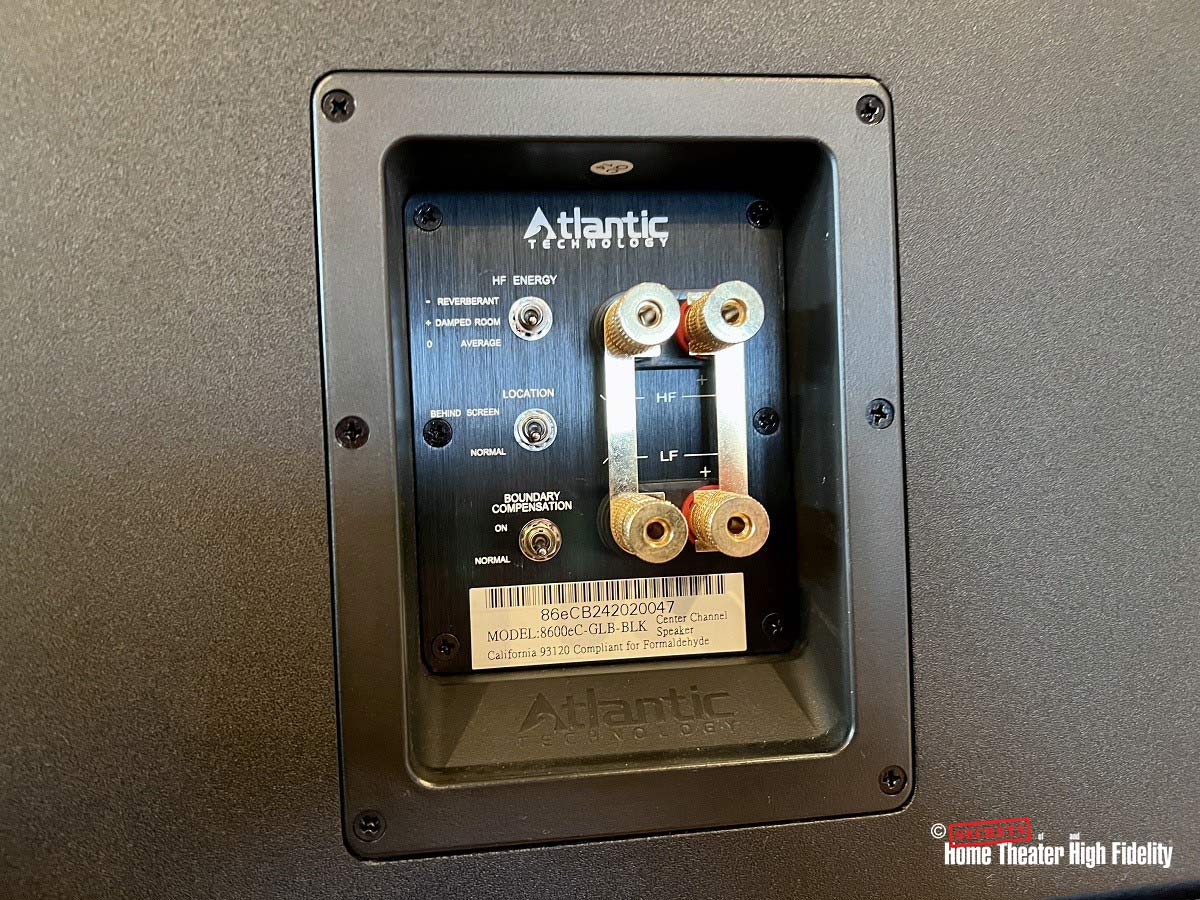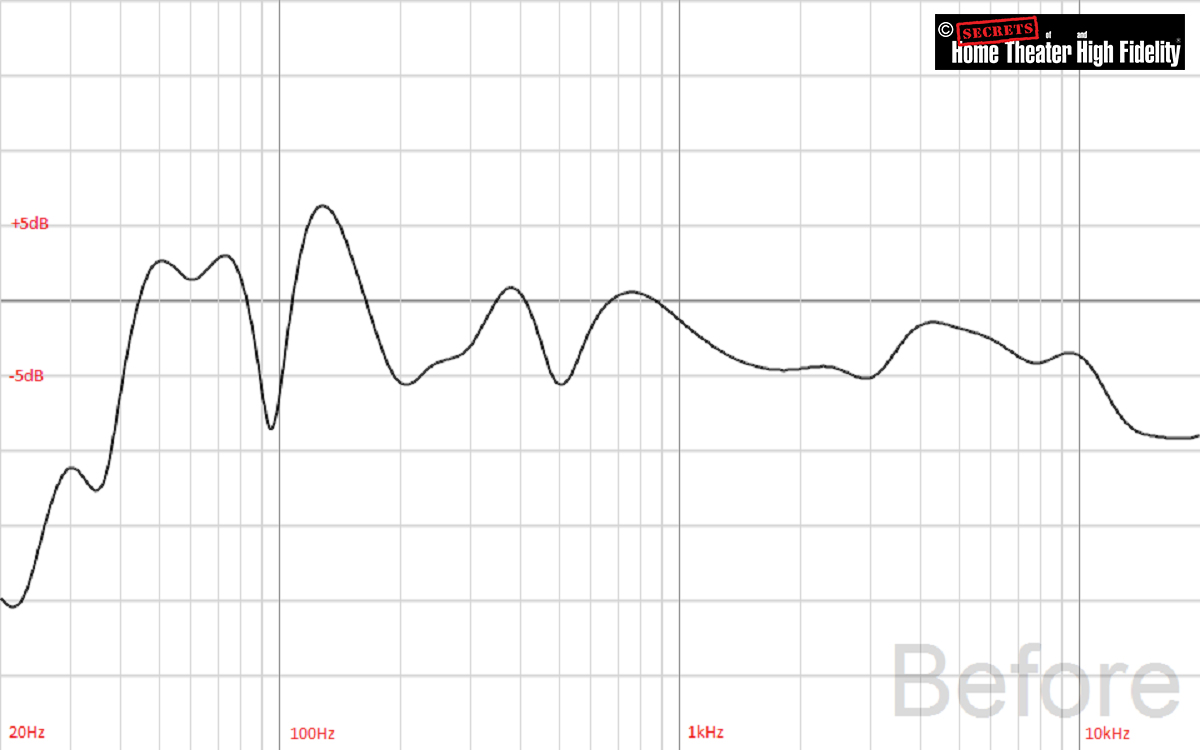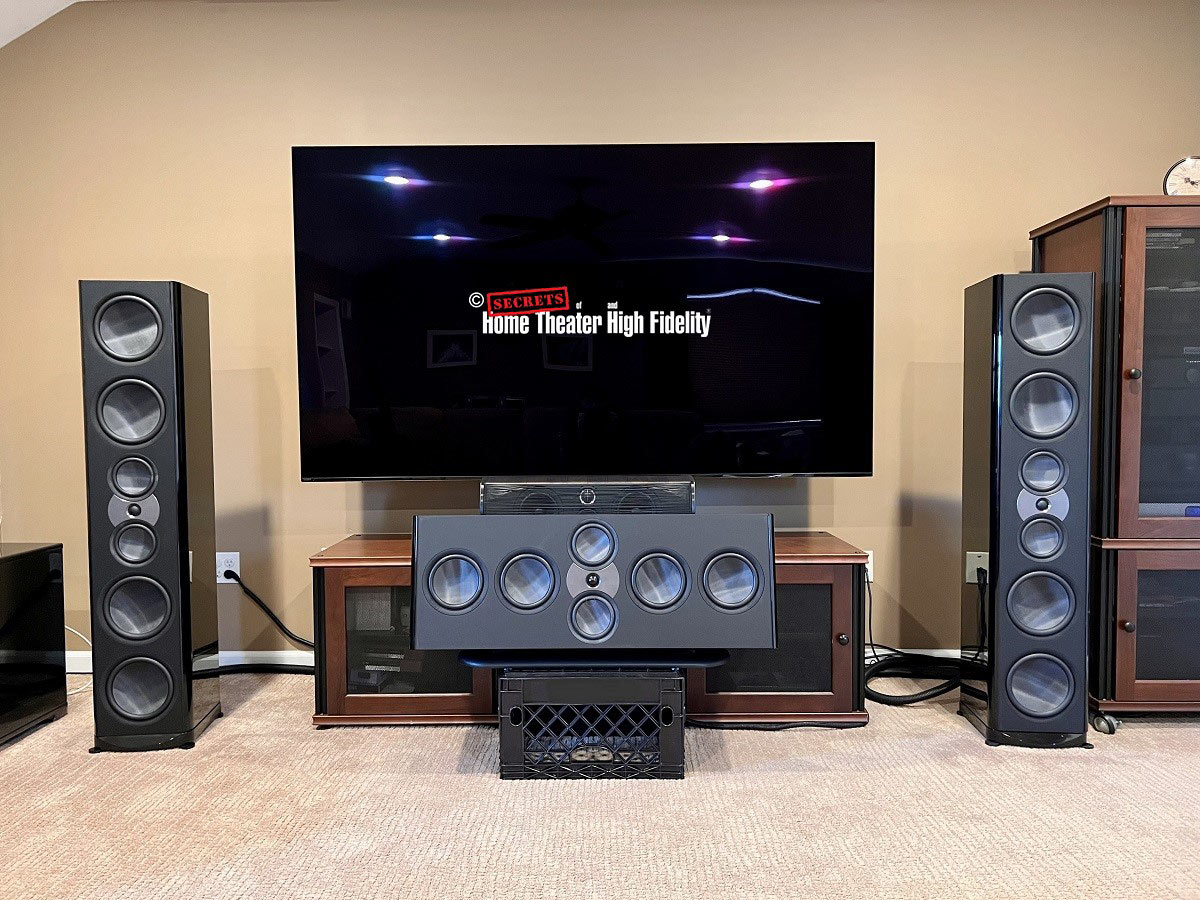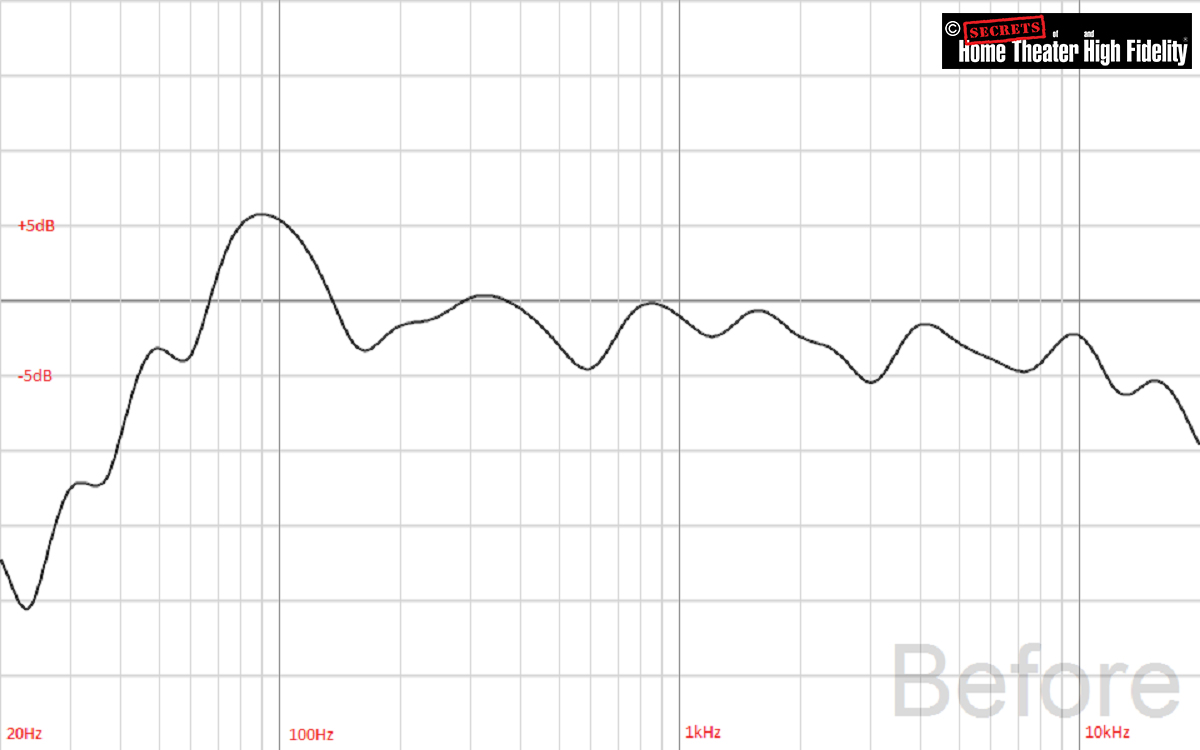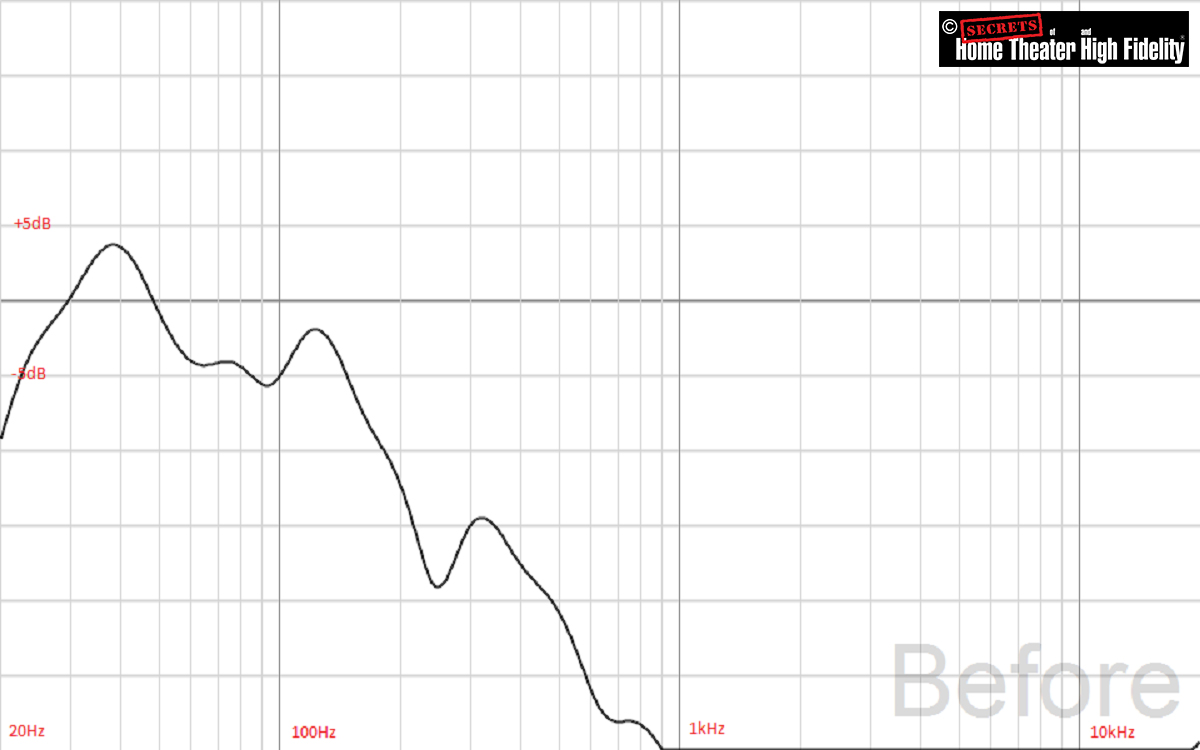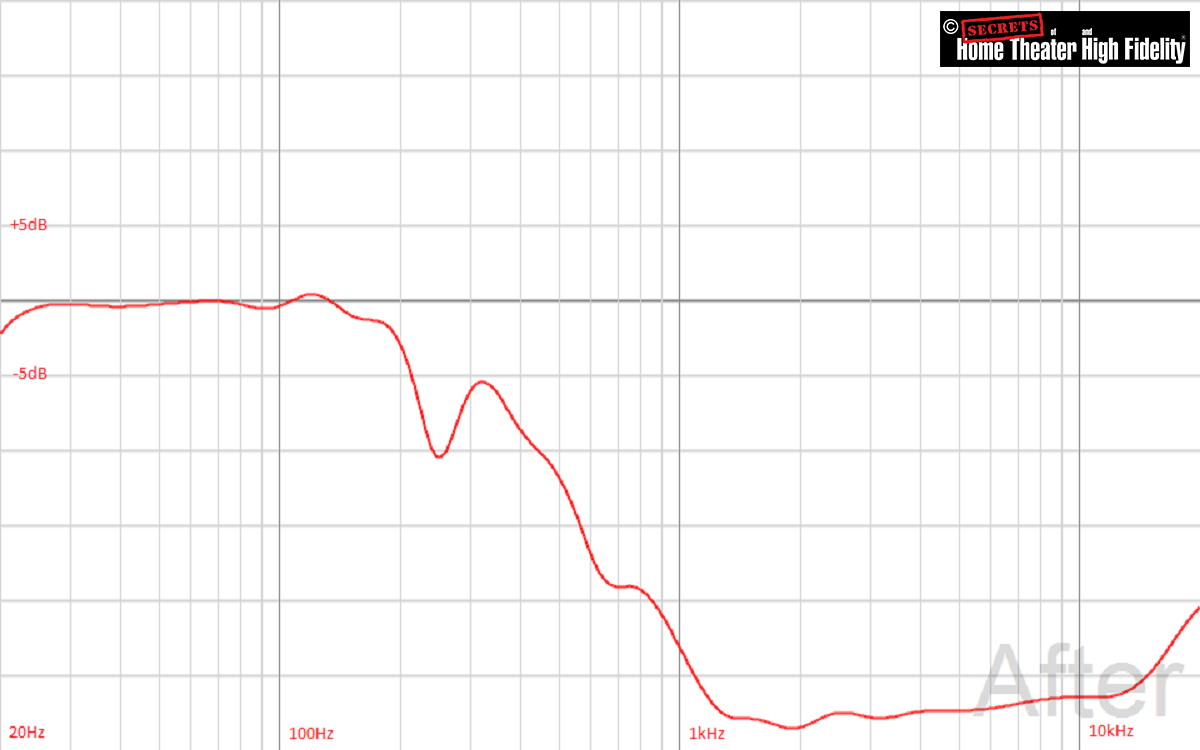Designed as Atlantic Technology’s flagship home theater system, the new 8600e series speakers were made for no-compromise theater rooms where sheer output levels are key.
Atlantic Technology 8600e Loudspeaker System
- Capable of very high output levels
- Multiple adjustment options for the 8600eLR and 8600eC speakers
- Excellent dialogue intelligibility with 8600eC center
- Wide “sweet spot” with the 8600eC center
- Detailed treble presentation
- Good imaging
- Crisp bass/mid-bass response
- Sealed design allows for flexible room placement
- 8200eSR surrounds offer dipole/bipole options
- SBT1000 delivers lots of output above 25Hz
Atlantic Technology has been around for a good amount of time now. However, Secrets hasn’t reviewed any of their gear since the Gatecrasher soundbar back in 2018. Their last full-size speaker system we reviewed was their 4400 system back in 2009. We also reviewed the 8200e system, the predecessor to today’s subject way back in 2007. Atlantic Technology has continued to have a strong presence in the dedicated home theater market, so when the opportunity to review Atlantic Technology’s current flagship system presented itself, I jumped at the chance. As a fan of big speaker systems, I figured that the 8600e system would be right up my alley.
Secrets Sponsor
8600eLR Tower
Design:
3-way sealed tower loudspeaker
Drivers:
1 x 1” aluminum/magnesium tweeter, 2 x 5.25” glass fiber midrange, 4 x 8” glass fiber woofers
Crossover:
Butterworth 4th order @ 450Hz and 3,000Hz
Frequency Response:
50Hz-25kHz +/- 2dB
Sensitivty:
91dB SPL
Nominal Impedance:
6ohm
Recommended Amplifier Power:
25-300W RMS
Dimensions (W x H x D):
10.9 x 51.7 x 11.4”
Weight:
93.3lbs each
Warranty:
5 years – parts and labor
MSRP:
$6,100/pair
8600eC Center Channel
Design:
3-way sealed center-channel loudspeaker
Drivers:
1 x 1” silk dome tweeter, 2 x 5.25” glass fiber midrange, 4 x 6.5” glass fiber woofers
Crossover:
450Hz and 3,000Hz
Frequency Response:
50Hz-25kHz +/- 2dB
Sensitivity:
93dB SPL
Nominal Impedance:
6ohm
Recommended Amplifier Power:
25-300W RMS
Dimensions (W x H x D):
37.6 x 13.7 x 14.5”
Weight:
91.5lbs
Warranty:
5 years – parts and labor
MSRP:
$2,500 each
8200eSR Surround
Design:
2-way sealed Dipolar/Bipolar surround loudspeaker
Drivers:
2 x 1” silk dome tweeter, 2 x 5.25” glass fiber mid/woofer
Crossover:
3,000Hz
Frequency Response:
80Hz-20kHz +/- 2dB
Sensitivity:
90dB SPL
Nominal Impedance:
6ohm
Recommended Amplifier Power:
15-150W RMS
Dimensions (W x H x D):
10.8 x 15.3 x 7.8”
Weight:
20lbs each
Warranty:
5 years – parts and labor
MSRP:
$1,900/pair (matching pedestal stands $890/pair)
SBT1000 Subwoofer
Design:
sealed acoustic suspension powered subwoofer
Drivers:
2 x 12” long-throw composite woofers
Crossover:
40Hz-140Hz adjustable, 24dB per octave Low Pass
Frequency Response:
23Hz-300Hz +/- 3dB (Max Range mode), 29Hz-300Hz (Max SPL mode)
Amplifier Power:
1000W RMS
Amplifier Type:
Class D
Inputs:
2 x XLR, 2 x RCA
Dimensions (W x H x D):
22.4 x 22.9 x 22.4”
Weight:
110lbs
Warranty:
3 years – parts and labor
MSRP:
$2,999
Website:
Company:
SECRETS Tags:
atlantic technology, center channel, loudspeaker, subwoofer, surround, system, tower, 8600e, 8600eC, 8600eLR, 8200eSR, SBT1000
Secrets Sponsor
While I consider myself a fan of large speakers, I don’t know if I was truly prepared for the massive size of the Atlantic Technology 8600eLR and 8600eC speakers. The 8600eLRs’ 51.7” height is truly imposing in person unless you have a really big room or 9-foot plus high ceilings. However, with their relatively narrow width and shallow depth, they don’t take up any more floor space than a small bookshelf speaker placed upon a stand. The overall design is fairly utilitarian, with the cabinets being almost perfectly rectangular. Fortunately, Atlantic Technology beveled the front corners to break up the straight lines, which keeps the 8600eLRs from looking too blocky. The cabinet panels are made from MDF that is CNC machined at Atlantic Technology’s factory in China. Finish choices for the side panels are piano gloss black or an optional Makassar Ebony veneer, both of which have ecologically sensitive glossy topcoats. The top panel and front baffle are covered with a textured matte black veneer. Set into the front baffle in a true D’Appolito array is a single 1” aluminum/magnesium tweeter with a 5.25” fiberglass midrange driver above and below it. Finishing things off are four 8” fiberglass woofers; two above and two below the MTM array. This design puts the tweeter below most seated ear-level positions, so the tweeter is aimed slightly upward in the housing and produces a bit more energy to better blend in with the 8600eC center. Magnetically attached grilles are included to cover up the drivers if you wish. I was in for a bit of a shock with I first attempted to remove the grilles. The magnets are the strongest I’ve ever seen on a speaker grille, requiring some real effort to remove. Once I did get them free, I understood why the magnets were so strong – these things are seriously heavy. Each grille is easily over 10 pounds and consists of a solid frame made of Bakelite (the first plastic made from synthetic materials – look it up) with thick metal mesh over the driver holes. Then the whole grille is covered in black fabric. The back panel houses dual pairs of 5-way binding posts that felt fairly solid and accepted my banana plugs without issue. Next to the binding posts are three switches for further tailoring the 8600eLRs’ sound to your room. There is a “Boundary Compensation” switch for either normal placement of the speaker out into the room (as I did) or right up next to a wall or within a cabinet, such as you might find if you have alcoves for the speakers behind a projection screen. A “Location” switch has a setting for behind a projection screen or unobstructed. The “Behind Screen” setting adds extra output in the upper mid-range/treble region. Lastly, there is an “HF Energy” switch with three settings: Reverberant, which decreases treble output, Damped Room, which increases treble output, and Normal. Metal outrigger extensions are included to increase the stability of the tall and narrow speakers. Metal spikes or rubber tips can then be screwed into the outriggers depending upon what type of flooring you have in your room.
The 8600eC is the largest center channel I have ever seen outside of a commercial cinema. Its 37.6” wide by 13.7” tall cabinet houses the most drivers I’ve ever seen in a consumer-grade center channel as well. Following the design trend set by the 8600eLR, the side and back panels were finished in piano-gloss black (Makassar Ebony is optional) with the same textured black veneer covering the front baffle and top panel of the speaker. There is a rounded portion on the bottom of the speaker that sits inside of a flat MDF base. You can then rotate the speaker up or down to fire directly at your listening position. In an effort to ensure the maximum horizontal dispersion, the 8600eC’s drivers are arranged in a pure D’Appolito array, with the single 1” silk dome tweeter flanked above and below by the two 5.25” fiberglass midrange drivers. Two 6.5” fiberglass woofers are set on each side of the M-T-M array. Moving around back, there are dual 5-way binding posts, and the same three adjustment switches present on the 8600eLRs.
For surround use, Atlantic Technology sent me a pair of 8200eSRs. These are a very interesting design as they can operate as either a dipole or bipole speaker. The 8200eSRs look like a triangle when viewed from above and house a 1” silk-dome tweeter and a single 5.25” fiberglass mid/woofer on each of the two faces. The dipole mode is recommended for movie watching, as it uses both sets of drivers to create a more diffuse sound effect. The bipole mode is the recommendation for surround music sources as it only engages one set of the drivers, creating a more localized sound. A switch allows you to easily flip between the two modes. On the back panel is a single set of 5-way binding posts as well as two keyhole openings for mounting the 8200eSRs on a wall. If wall mounting, try to mount to a stud or use heavy-duty wall anchors, as each weighs in at 20 pounds. The speakers are finished in satin black and include magnetically attached grilles for each speaker’s face.
Atlantic Technology also sent me one of their flagship SBT1000 subwoofers. This is a monster of a sub, coming in at 110 pounds and roughly 22.5 inches cubed. The bulk of the weight comes from the two 12” composite-coned drivers, which offer some pretty beefy magnets and motor structures. The drivers are set up in a direct-opposing fashion so that the vibration from one driver cancels out the other. The sealed cabinet is made up of HDF with extensive internal bracing and felt very solid. Finish choices are either piano gloss black (like my review sample) or a less conspicuous matte black. The drivers can be covered by black cloth grilles that oddly don’t use magnetic attachments like the other 8600e/8200e speakers. Instead, they use the old-school peg-in-hole type that leaves four visible holes in the cabinet if you choose to remove the grille. On the back is the heat sink for the 1000w amplifier and the SBT1000’s control panel. Speaking of the amplifier heatsink, I noticed that the fins for the heatsink were especially sharp, particularly on the top and bottom edges. Perhaps it was just my sample, but the edges were sharp enough to tear a dust cloth I used to clean the speaker, so I’d imagine they could cut a finger too. The amp panel also houses left and right channel XLR inputs, left and right channel line in (RCA) inputs, a phase switch (0 or 180 degrees), a switch to set the SBT1000 to “Max Range” or “Max Extension” mode, a volume knob, a crossover engagement switch, an adjustable crossover knob (40-140Hz), a power stand-by light, and a switch to set the sub on, off, or to automatically power on when a signal is detected. At the bottom of the panel is a covered switch to select input voltage, the main power switch, and a dual-prong IEC power cable socket. Four rubber feet are attached to the bottom of the cabinet.
Lugging speakers up the 13 steps to my media room is never fun, and the big Atlantics were especially difficult with their huge boxes and high weight. I HIGHLY recommend you get help moving these monsters. Once the speaker-moving workout session was over, I got the 8600eLRs unboxed and set up in my standard position within my media room. After attaching the outriggers and the metal spikes, I removed the jumpers on the 8600eLRs’ binding posts and used Kimber 4VS bi-wired cable to connect my reference Wyred4Sound multi-channel amp, which outputs around 750 watts at the 8600eLRs 6-ohm rating. The amp was connected to my Marantz AV8801 pre/pro via Blue Jeans XLR cables. All music was fed to the AV8801 via an Oppo BDP-205 Universal player, connected to the pre/pro via HDMI as well as analog XLR outputs for 2-channel sources so that I could take advantage of the better DAC in the Oppo player. I also used an Amazon Fire TV 4k stick for some streaming content.
I started off with the speakers about 3’ from the front wall of my 22 x 28’ media room and about 4’ from the side walls. While this position typically works with most speakers, I found that the 8600eLRs didn’t seem to have much bass response below about 60Hz or so. Moving the speakers a foot closer to my front wall added a touch more bass output, but not much extra depth. Any closer than two feet from my front wall resulted in a lot of boominess in the bass, so I settled on a final position with the rear of the 8600eLRs’ cabinets at exactly 24 inches from the front wall, which got me solid response down to about 50Hz, but it dropped quickly below that. This is in line with Atlantic Technology’s 50Hz spec. While I was a bit surprised that such a large speaker with four 8” woofers could only reach down to about 50Hz, you have to remember that these speakers were designed for a home theater system, where there will always be at least one subwoofer to reproduce the lowest frequencies. Since your main left/right speakers will rarely be in the optimum position to reproduce low bass, it is best to leave that duty to your sub(s), which can be placed for the smoothest overall bass response in your room. This also allows the speaker to play a lot louder, as it does not have to reproduce the lowest frequencies. While you can’t really adjust the rake of the 8600eLRs due to the short thread length of the tips and rubber feet, I did spend some time experimenting with toe-in and found that I got the smoothest overall treble and midrange with the speakers aimed at a point roughly 10 feet behind my head. This also seemed to give the best stereo image. Aiming the speakers directly at my listening position further emphasized the upper midrange and lower treble, so this was a non-starter for me. In what is a rare occurrence for me, I also found that I preferred the sound of the 8600eLRs with their grilles on. Removing them increased the energy coming from the tweeter and midrange, giving things an even brighter tonal balance. Below is a screenshot from my Audyssey Pro calibration, showing the frequency response of the right 8600eLR in my room before correction. The peak at 125Hz is room/seating position induced as is the null at 95Hz. Mid-bass and lower midrange response was fairly flat in my room but take note of the pretty significant 6dB drop from about 800Hz down to about 3kHz, where it then proceeds to shoot back up almost 5dB again towards 4500kHz. I’ll address later whether this has any adverse effect on how the 8600eLRs sound.
With the 8600eLRs in place, I turned my attention to the 8600eC center channel. The extreme size of the center meant that I couldn’t place it on my Salamander Triple 20 console as I usually do without blocking a significant portion of my TV screen. Fortunately, a milk crate I use for record storage proved to be the perfect height for a make-shift speaker stand. I placed the 8600eC’s stand on top of the upside-down milk crate and then carefully lowered the 91-pound center channel onto the stand. You have to line up the grooves of the stand with the rounded extension on the bottom of the 8600eC to get things right. Again, an assistant makes this task much easier. With the speaker now in its cradle, you can adjust the tilt of the 8600eC to get it to fire directly towards your ear height. With my slightly low stand, I had to angle the 8600eC up to get it aimed correctly. The 8600eC swivels easily in the cradle so adjustment is not hard, but there is no way to “lock” the speaker into position. As such, any time you touch the speaker it will swivel out of your preferred position. This is pretty easy to fix, so I’d like to see Atlantic Technology address this in the future. The 8600eC sounded best with the speaker aimed directly at my ear level, any higher or lower changed the sound noticeably. I connected a single run of Kimber 4VS cable between the 8600eC and my Wyred4Sound amp. All three back panel switches were left in their default positions. The picture below shows the 8600eC and 8600eLRs set up in my room. For reference, that is an 83” OLED sitting above the 8600eC and you can see my Sonus faber Olympica Center peeking out above the 8600eC. The 8600eC makes my TV look like a 65” in comparison and absolutely dwarfs the Olympica Center, which is not exactly a small center speaker itself.
I placed the 8200eSRs on the matching stands that Atlantic Technology sent me ($890/pair) and placed those off to the sides of my listening position at the standard 120-degree recommendation. I really liked the matching stands as they are taller than normal and put the speakers at the perfect height for me: slightly above my seated ear level. If you can’t wall mount, these are a great option. I placed the SBT1000 subwoofer at a point along my rear wall, swapping out my reference Hsu ULS-15MkII for the SBT1000. I also disabled my other reference sub to ensure I was hearing only the SBT1000. The sub was left in the “Max Extension” mode to get the deepest bass output. As the final step in my setup process, I ran a full Audyssey Pro calibration on my Marantz AV8801 pre/pro. This made sure that distance, level, and EQ were set correctly for all of the speakers before testing any multi-channel sources. I initially set Audyssey to use the “midrange compensation” dip as it followed the natural response curve of the 8600eLR and 8600eC speakers. One thing I noticed during my calibration run was that the 8600eLRs seemed to have a slightly different timbre than the 8600eC and 8200eSRs. The Audyssey calibration “quack” seemed brighter in tone on the 8600eLRs than on the other speakers.
As I typically do, I started my listening sessions on the 8600e setup with some good old-fashioned stereo content. To ensure I was getting the cleanest signal possible, I set my Marantz pre-pro to its “Pure Direct” mode (which disables all EQ/processing/subwoofers) and set my Oppo UHD player to output an analog signal via its XLR outputs. I used Gary Clark Jr’s “When My Train Pulls In” from Blak and Blu (24-bit/96kHz FLAC) to evaluate my setup choices. The kick drum had a nice weight and was very crisp as I expected given the four 8” woofers and sealed cabinet design of the 8600eLR. The approximate 50Hz depth was adequate, but bass junkies will certainly want to use a subwoofer. The guitar and vocals had a very clean quality to them, with excellent clarity. However, there was a very bright overall character in the upper midrange/lower treble area. This gave a harder edge to higher register guitar notes as well as the cymbals from the drum kit. I experimented with the “HF Energy” switch on the 8600eLRs’ back panel but even the “bright” position (which lowers treble output) didn’t seem to help. It did, however, cut some of the “air” and spaciousness from the cymbals so I went back to the “Normal” position. The imaging was very good, with Clark Jrs.’ vocals being locked very solidly in the space between the two towers. I switched on the Audyssey Pro processing on my pre/pro and found that this did seem to help the harshness somewhat, but I still found the overall sound a bit fatiguing, particularly at higher volume levels.
Just to make sure that this recording wasn’t the issue, I moved to some well-recorded classical music. After shutting the Audyssey processing back off, I loaded up Rachmaninoff’s “Symphonic Dances” (Reference Recordings RR-96, 96kHz/24-bit FLAC) from my NAS drive via the Oppo. The French horns that are prominent throughout the first few minutes of “Andante Con Moto” displayed the same harshness that I heard earlier, with a more metallic “bite” than they should have. Engaging Audyssey EQ once again tamed the brightness to some extent, but not enough for my taste. The kettle drums were nice and tight but didn’t resolve the full depth and fullness of the instrument due to the lack of deep bass output. As an experiment, I went back to my Audyssey Pro setup and removed the midrange compensation dip. This helped reduce the perceived harshness as it brought the lower presence region energy up, but there was still a lot of bite in the upper presence area (4-6 kHz). My ears are particularly sensitive in this region, so others may not find this extra energy bothersome. Letting this track play through I noticed that while the 8600eLRs did a good job of locking the stereo image in space right between the two speakers, they seemed to diminish the soundstage width and depth compared to other speakers I have had in my room. Dynamics also seemed a bit compressed as well. While the 8600eSRs could play loud, the sound didn’t jump out at me during the transitions between quiet pianissimo moments and the louder fortissimo parts as well as other speakers I have heard in my room. However, with the SBT1000 subwoofer now engaged, the power and the depth of the bass response improved dramatically. The SBT1000 delivered those drums with real punch and also did a nice job reproducing the flutter of the skins. The transition from the sub to the 8600eSRs at the Audyssey-selected 60Hz point was smooth, with everything seeming to come from a single speaker.
To finish testing the SBT-1000 I put on my favorite bass torture test disc, “Bass Jamz: Maximum Techno Bass Mix” (CD: Neurodisc B000003AHU). The SBT-1000 did an excellent job keeping up with the rapidly changing bass lines but the lack of sub-25Hz bass was fairly noticeable. Most tracks on this disc contain bass down to 15Hz (or lower) and I’ve become accustomed to hearing those notes with authority from my reference Hsu subwoofers. As the raw and corrected Audyssey plots below show, the SBT1000 couldn’t quite pull off the neat trick of vibrating my backside with subsonic bass as the bass response dropped rapidly below 30Hz in my room, even post-Audyssey correction. I pushed the volume past 100dB and the SBT1000 displayed no signs of strain, remaining clean and tight.
Switching to my DVD-Audio copy of the Beatles’ “Love” I did some more in-depth testing utilizing the 5.1 channel high-resolution mix. The intro track, “Because” presents the vocals evenly across the front three channels. Placing my head a few feet from the speakers and moving from the center to the left or right and back again, I could easily hear the timbral difference between the 8600eLRs and the 8600eC, with the center channel presenting a more organic, smoother take on the upper regions. Engaging Audyssey and removing the midrange compensation dip further improved the overall tonal balance, so I kept Audyssey engaged for the remainder of my listening. “While My Guitar Gently Weeps” is mixed very center-heavy, with George Harrison’s vocal emanating strictly from the center channel. This is a great test for a center channel speaker. While I would still characterize the 8600eC’s overall sound as bright, it wasn’t painfully so and showed excellent clarity and definition with Harrison’s vocals. The 8200eSRs filled in the surrounding field nicely, adding ambiance and space to this fantastic mix. I repeated the track a few times, switching the 8200eSRs between dipole and bipole mode before finally deciding that I preferred the bipole mode for its more direct presentation of the surround channels’ information. The dipole mode also sounded good, but definitely presented a more diffuse effect for the rear channels.
With a good handle on the 8600e system’s capabilities, I switched over to some movie watching. The introduction scene from the 4K UHD disc of “The Greatest Showman” is a great test of the dynamics of a system. The 8600e system did well with the lossless Dolby Atmos soundtrack, with very tight thumps as the crowd in the bleachers stomps their feet in unison. The SBT1000 was really in its element here, helping the footfalls punch me in the chest with power. I could still make out the harsher tonal character of the 8600eLRs in the chanting voices, but it was less noticeable with all of the other speakers engaged. The 8200eSRs did their part as well, reproducing the clomping horse hoofs and other ambient effects nicely, particularly in the more diffuse dipole mode. While it is sometimes hard to hear the whisper-like words spoken by Hugh Jackman on some systems, the 8600eC’s slightly brighter character made things easy for me to understand. The movie quickly shifts into “A Million Dreams” with the young boy’s voice delivered mostly through the center channel. The 8600eC impressed here with its clear and detailed vocal presentation.
Speakers like these beg for large-scale action movies so I pulled out some old favorites. “The Matrix” on 4k UHD disc is still a powerhouse to this day. The training sequence in the dojo between Morpheus and Neo sounded very good, with particularly punchy bass from the kicks, punches, and crashes as they fight around the room. The rooftop fight scene sounded pretty awesome, with the “bullet-time” effects really shining through the 8200eSRs in dipole mode. The lobby shooting spree was immersive but was slightly marred by the gunshots sounding a bit too bright. The huge bomb going off in the elevator and the crash of the helicopter really highlighted the tremendous output capability of the SBT1000 subwoofer, shaking the walls of my media room. The dialogue through the center channel continued to be a strong point too, with no issues making out words even during some of the louder passages.
I finished up my movie sessions with “Blade Runner: 2049” on 4k UHD disc. The Dolby Atmos mix on this disc is one of the best I’ve heard in many years, and it begs to be played loud. The introduction has an incredibly powerful score that can just about push you back in your seat at high volume levels. The 8600e system was certainly up to the task, easily playing back at near-stupid levels of output with all of the speakers energizing the room around me. K’s journey to the LAPD sequence is another great example of the film’s powerful soundtrack. However, the CS-80 synthesizer effects used here to create the score fell victim to the harsh overall character of the 8600eLRs, with the notes taking on more of a piercing effect that forced me to lower the volume considerably. The SBT1000 continued to pummel away without issue, putting out some serious bass. Yes, it couldn’t deliver the lowest notes of this score, but its overall output level was pretty impressive for a single sub, pressuring my nearly 5,000 cubic foot room.
While the Atlantic Technology 8600e system can offer reference-level playback even in a large theater room, its issues with music reproduction make it a tough recommendation given its price point.
- Longer spikes for the 8600eLRs
- Locking mechanism for 8600eC’s stand
- Noticeable “hardness” to the upper midrange/lower treble on the 8600eLR
- Better timbre matching between the 8600eC and 8600eLRs
- Improved sound staging on 8600eLRs
- More musical midrange on 8600eLRs
- Improved dynamics
- More sub-25Hz output from the SBT1000 subwoofer
- Switch to a magnetically attached grille on the SBT1000
Over the years, there have been a lot of speakers that have been classified as “home theater speakers.” I’d put the Atlantic Technology 8600e system firmly into that category. From some of the design choices, you can tell that the speakers were designed to excel at movie reproduction. While I really can’t recommend this system for use in 2-channel or multi-channel music-first systems, its performance on film soundtracks was significantly better. The sheer output levels may endear this system to those who value raw power above all else. The slight timbral mismatch between the 8600eLRs and the 8600eC was less noticeable with movie soundtracks as long as EQ was applied. However, I would still like to see Atlantic Technology address this in the future. Perhaps switching to the silk-dome tweeter from the 8600eC or adjusting the crossover tuning could help smooth out the 1-6kHz performance and match the 8600eLR up better with the center and surround speakers. This would go a long way towards addressing some of the harshness I observed in the upper midrange/lower treble as well. If you are looking for a surround system that can give you that “Maxell Moment,” and prefer an inherently brighter sound, the Atlantic Technology 8600e system could be a good fit for you.




